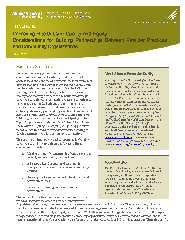As many as 85 percent of primary care physicians (PCPs) feel that to achieve good health outcomes, it is as important to address patients’ resource and social constraints as it is to treat their medical conditions. Yet, the traditional medical system is not designed to meet the full array of patient needs. Factors that often have the most significant impact on health—the environments in which individuals live, work, and play and their behaviors—are outside of the traditional clinical care system.
By working with community organizations that specialize in meeting these needs, practices help their patients overcome day-to-day hurdles such as poor housing, lack of transportation, low health literacy and hunger.
Community organizations can in turn help practices better understand local resources, gain trust of patients and families, and serve as a referral service for much-needed support. This brief outlines considerations for practices looking to develop partnerships with community organizations.
This paper examines four critical components for building partnerships and key considerations for each. These components include:
- Making the case for partnerships from the practice, patient, and community perspectives;
- A framework and examples of partnership arrangements between practices and community entities;
- Building blocks and activities to develop successful partnerships; and
- Levers for sustaining practice-community partnerships.


